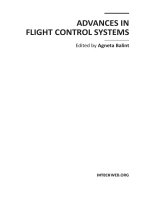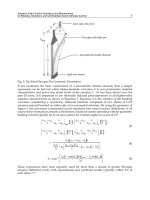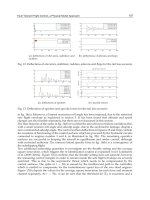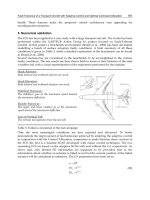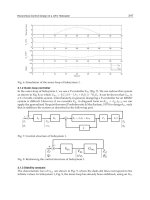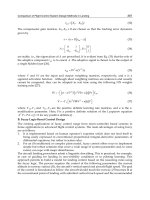Advances in Vibration Analysis Research Part 1 doc
Bạn đang xem bản rút gọn của tài liệu. Xem và tải ngay bản đầy đủ của tài liệu tại đây (986.36 KB, 30 trang )
ADVANCES IN VIBRATION
ANALYSIS RESEARCH
Edited by Farzad Ebrahimi
Advances in Vibration Analysis Research
Edited by Farzad Ebrahimi
Published by InTech
Janeza Trdine 9, 51000 Rijeka, Croatia
Copyright © 2011 InTech
All chapters are Open Access articles distributed under the Creative Commons
Non Commercial Share Alike Attribution 3.0 license, which permits to copy,
distribute, transmit, and adapt the work in any medium, so long as the original
work is properly cited. After this work has been published by InTech, authors
have the right to republish it, in whole or part, in any publication of which they
are the author, and to make other personal use of the work. Any republication,
referencing or personal use of the work must explicitly identify the original source.
Statements and opinions expressed in the chapters are these of the individual contributors
and not necessarily those of the editors or publisher. No responsibility is accepted
for the accuracy of information contained in the published articles. The publisher
assumes no responsibility for any damage or injury to persons or property arising out
of the use of any materials, instructions, methods or ideas contained in the book.
Publishing Process Manager Ivana Lorkovic
Technical Editor Teodora Smiljanic
Cover Designer Martina Sirotic
Image Copyright Leigh Prather, 2010. Used under license from Shutterstock.com
First published March, 2011
Printed in India
A free online edition of this book is available at www.intechopen.com
Additional hard copies can be obtained from
Advances in Vibration Analysis Research, Edited by Farzad Ebrahimi
p. cm.
ISBN 978-953-307-209-8
free online editions of InTech
Books and Journals can be found at
www.intechopen.com
Chapter 1
Chapter 2
Chapter 3
Chapter 4
Chapter 5
Chapter 6
Chapter 7
Chapter 8
Preface IX
Transverse Vibration Analysis
of Euler-Bernoulli Beams Using
Analytical Approximate Techniques 1
Safa Bozkurt Coşkun, Mehmet Tarik Atay and Baki Öztürk
Vibration Analysis of Beams
with and without Cracks Using
the Composite Element Model 23
Z.R. Lu, M. Huang and J.K. Liu
Free Vibration Analysis of Curved Sandwich Beams:
A Dynamic Finite Element 37
Seyed M. Hashemi and Ernest J. Adique
Some Complicating Effects
in the Vibration of Composite Beams 57
Metin Aydogdu, Vedat Taskin, Tolga Aksencer,
Pınar Aydan Demirhan and Seckin Filiz
Independent Coordinate Coupling Method
for Free Vibration Analysis of a Plate With Holes 79
Moon Kyu Kwak and Seok Heo
Free Vibration of Smart Circular Thin FGM Plate 103
Farzad Ebrahimi
An Atomistic-based Spring-mass Finite
Element Approach for Vibration Analysis
of Carbon Nanotube Mass Detectors 115
S.K. Georgantzinos and N.K. Anifantis
B-spline Shell Finite Element Updating
by Means of Vibration Measurements 139
Antonio Carminelli and Giuseppe Catania
Contents
Contents
VI
Dynamic Analysis of a Spinning Laminated
Composite-Material Shaft Using
the hp-version of the Finite Element Method 161
Abdelkrim Boukhalfa
The Generalized Finite Element Method
Applied to Free Vibration of Framed Structures 187
Marcos Arndt, Roberto Dalledone Machado and Adriano Scremin
Dynamic Characterization
of Ancient Masonry Structures 213
Annamaria Pau and Fabrizio Vestroni
Vibration Analysis of Long Span Joist Floors
Submitted to Human Rhythmic Activities 231
José Guilherme Santos da Silva, Sebastião Arthur Lopes de
Andrade, Pedro Colmar Gonçalves da Silva Vellasco,
Luciano Rodrigues Ornelas de Lima and Rogério Rosa de Almeida
Progress and Recent Trends in the Torsional
Vibration of Internal Combustion Engine 245
Liang Xingyu, Shu Gequn, Dong Lihui, Wang Bin and Yang Kang
A Plane Vibration Model for Natural Vibration
Analysis of Soft Mounted Electrical Machines 273
Ulrich Werner
Time-Frequency Analysis
for Rotor-Rubbing Diagnosis 295
Eduardo Rubio and Juan C. Jáuregui
Analysis of Vibrations and Noise
to Determine the Condition of Gear Units 315
Aleš Belšak and Jurij Prezelj
Methodology for Vibration Signal Processing
of an On-load Tap Changer 329
Edwin Rivas Trujillo, Juan C. Burgos Diaz and Juan C. García-Prada
Analysis of Microparts Dynamics Fed Along
on an Asymmetric Fabricated Surface
with Horizontal and Symmetric Vibrations 343
Atsushi Mitani and Shinichi Hirai
Vibration Analysis of a Moving Probe
with Long Cable for Defect Detection of Helical Tubes 367
Takumi Inoue and Atsuo Sueoka
Chapter 9
Chapter 10
Chapter 11
Chapter 12
Chapter 13
Chapter 14
Chapter 15
Chapter 16
Chapter 17
Chapter 18
Chapter 19
Contents
VII
Vibration and Sensitivity Analysis of Spatial Multibody
Systems Based on Constraint Topology Transformation 391
Wei Jiang, Xuedong Chen and Xin Luo
Non-Linear Periodic and Quasi-Periodic
Vibrations in Mechanical Systems -
On the use of the Harmonic Balance Methods 419
Emmanuelle Sarrouy and Jean-Jacques Sinou
Support Vector Machine Classification of Vocal Fold
Vibrations Based on Phonovibrogram Features 435
Michael Döllinger, Jörg Lohscheller,
Jan Svec, Andrew McWhorter and Melda Kunduk
Chapter 20
Chapter 21
Chapter 22
Pref ac e
Vibrations are extremely important in all areas of human activities, for all sciences,
technologies and industrial applications. Sometimes these vibrations are harmless, of-
ten they can be noticed as noise or cause wear. Vibrations, if they are not desired, can
be dangerous. But sensibly organized and controlled vibrations may be pleasant (think
of all kinds of music) or vitally important (heartbeat). In any case, understanding and
analysis of vibrations are crucial.
This book reports on the state of the art research and development fi ndings on this
very broad ma er through 22 original and innovative research studies exhibiting vari-
ous investigation directions.
In particular, it introduces recent research results on many important issues at the vi-
bration analysis fi eld such as vibration analysis of structural members like beams and
plates especially made of composite or functionally graded materials using analytical
and fi nite element method and shows some results on applications in vibration analy-
sis of framed structures, masonry structures and building vibration problems due to
human rhythmic activities.
It also presents related themes in the fi eld of vibration analysis of internal combustion
engines, electrical machines, sha s, rotors and gear units and some other interesting
topics like vibration analysis of carbon nanotube mass sensors, sensitivity analysis of
spatial multibody systems, analysis of microparts dynamics, defect detection of tubes
and vocal fold vibrations and introduces harmonic balance; topology-based transfor-
mation and independent coordinate coupling methods.
In summary, this book covers a wide range of interesting topics of vibration analysis.
The advantage of the book vibration analysis is its open access fully searchable by
anyone anywhere, and in this way it provides the forum for dissemination and ex-
change of the latest scientifi c information on theoretical as well as applied areas of
knowledge in the fi eld of vibration analysis.
The present book is a result of contributions of experts from international scientifi c
community working in diff erent aspects of vibration analysis. The introductions, data,
and references in this book will help the readers know more about this topic and help
them explore this exciting and fast-evolving fi eld.
X
Preface
The text is addressed not only to researchers, but also to professional engineers, stu-
dents and other experts in a variety of disciplines, both academic and industrial seek-
ing to gain a be er understanding of what has been done in the fi eld recently, and what
kind of open problems are in this area.
I hope that readers will fi nd the book useful and inspiring by examining the recent
developments in vibration analysis.
Tehran, February 2011
F a r z a d E b r a h i m i
Mechanical Engineering Department
University of Tehran
1
Transverse Vibration Analysis of
Euler-Bernoulli Beams Using
Analytical Approximate Techniques
Safa Bozkurt Coşkun
1
, Mehmet Tarik Atay
2
and Baki Öztürk
3
1
Kocaeli University, Faculty of Engineering,
Department of Civil Engineering 41380 Kocaeli,
2
Niğde University, Faculty of Arts and Science,
Department of Mathematics 51200 Niğde,
3
Niğde University, Faculty of Engineering,
Department of Civil Engineering 51200 Niğde,
Turkey
1. Introduction
The vibration problems of uniform and nonuniform Euler-Bernoulli beams have been
solved analytically or approximately [1-5] for various end conditions. In order to calculate
fundamental natural frequencies and related mode shapes, well known variational
techniques such as Rayleigh_Ritz and Galerkin methods have been applied in the past.
Besides these techniques, some discretized numerical methods were also applied to beam
vibration analysis successfully.
Recently, by the emergence of new and innovative semi analytical approximation methods,
research on this subject has gained momentum. Among these studies, Liu and Gurram [6]
used He’s Variational Iteration Method to analyze the free vibration of an Euler-Bernoulli
beam under various supporting conditions. Similarly, Lai et al [7] used Adomian
Decomposition Method (ADM) as an innovative eigenvalue solver for free vibration of
Euler-Bernoulli beam again under various supporting conditions. By doing some
mathematical elaborations on the method, the authors obtained i
th
natural frequencies and
modes shapes one at a time. Hsu et al. [8] again used Modified Adomian Decomposition
Method to solve free vibration of non-uniform Euler-Bernoulli beams with general
elastically end conditions. Ozgumus and Kaya [9] used a new analytical approximation
method namely Differential Transforms Method to analyze flapwise bending vibration
analysis of double tapered rotating Euler-Bernoulli beam. Hsu et al. [10] also used Modified
Adomian Decomposition Method, a new analytical approximation method, to solve
eigenvalue problem for free vibration of uniform Timoshenko beams. Ho and Chen [11]
studied the problem of free transverse vibration of an axially loaded non-uniform spinning
twisted Timoshenko beam using Differential Transform Method. Another researcher,
Register [12] found a general expression for the modal frequencies of a beam with
symmetric spring boundary conditions. In addition, Wang [13] studied the dynamic analysis
of generally supported beam. Yieh [14] determined the natural frequencies and natural
Advances in Vibration Analysis Research
2
modes of the Euler_Bernoulli beam using the singular value decomposition method. Also,
Kim [15] studied the vibration of uniform beams with generally restrained boundary
conditions. Naguleswaran [16] derived an approximate solution to the transverse vibration
of the uniform Euler-Bernoulli beam under linearly varying axial force. Chen and Ho [17]
studied the problem of transverse vibration of rotating twisted Timoshenko beams under
axial loading using differential transform method to obtain natural frequencies and mode
shapes.
In this study, transverse vibration analysis of uniform and nonuniform Euler-Bernoulli
beams will be briefly explained and demonstrated with some examples by using some of
these novel approaches. To this aim, the theory and analytical techniques about lateral
vibration of Euler-Bernoulli beams will be explained first, and then the methods used in the
analysis will be described. Finally, some case studies will be presented by using the
proposed techniques and the advantages of those methods will be discussed.
2. Transverse vibration of the beams
2.1 Formulation of the problem
Lateral vibration of beams is governed by well-known Bernoulli-Euler equation. To develop
the governing equation, consider the free body diagram of a beam element in bending
shown in Fig.1. In this figure, M(x,t) is the bending moment, Q(x,t) is the shear force, and
f(x,t) is the external force per unit length acting on the beam.
Fig. 1. Free-body diagram of a beam element in bending
Equilibrium condition of moments leads to the following equation:
0
M
MQx M
x
δ
∂
⎛⎞
+
−+ =
⎜⎟
∂
⎝⎠
(1)
or
2
2
Mw
QEI
xx
x
⎛⎞
∂∂∂
==
⎜⎟
⎜⎟
∂∂
∂
⎝⎠
(2)
x
w
x+
δ
x
x
Q
M
Q
Qx
x
δ
∂
+
∂
M
M
x
x
δ
∂
+
∂
Transverse Vibration Analysis of Euler-Bernoulli Beams Using Analytical Approximate Techniques
3
Since a uniform beam is not assumed in the formulation,
I(x) will be variable along beam
length.
The equation of motion in the tranverse direction for the beam element is:
2
2
() (,)
wQ
Ax fxt x Q Q
x
t
ρδ δ
∂∂
⎛⎞
=+−+
⎜⎟
∂
∂
⎝⎠
(3)
In Eq.(3),
ρ
is mass density of the material of the beam. After simplifications, Eq.(3) can be
rewritten as follows:
2
2
(,)
wQ
A
f
xt
x
t
ρ
∂∂
+=
∂
∂
(4)
In view of Eq.(2), governing equation for forced transverse vibration is obtained as below
which is the well known Euler-Bernoulli equation.
22 2
22 2
(,)
ww
EI A
f
xt
xx t
ρ
⎛⎞
∂∂ ∂
+=
⎜⎟
⎜⎟
∂∂ ∂
⎝⎠
(5)
For a uniform beam Eq.(5) reduces to
42
42
(,)
ww
EI A
f
xt
xt
ρ
∂∂
+=
∂∂
(6)
For the free vibration case, i.e. f(x,t)=0, the equation of motion becomes
22 2
22 2
0
ww
EI A
xx t
ρ
⎛⎞
∂∂ ∂
+
=
⎜⎟
⎜⎟
∂∂ ∂
⎝⎠
(7)
If the beam is uniform, i.e. EI is constant, the equation of motion in Eq.(7) reduces to
42
2
42
0
ww
c
xt
∂∂
+
=
∂∂
(8)
where
EI
c
A
ρ
= . (9)
Transverse vibration of beams is an initial-boundary value problem. Hence, both initial and
boundary conditions are required to obtain a unique solution w(x,t). Since the equation
involves a second order derivative with respect to time and a fourth order derivative with
respect to a space coordinate, two initial conditions and four boundary conditions are
needed.
2.2 Modal analysis
The solution to problem given by Eq.(5) can be produced by, first obtaining the natural
frequencies and mode shapes and then expressing the general solution as a summation of
Advances in Vibration Analysis Research
4
modal responses. In each mode, the system will vibrate in a fixed shape ratio which leads to
providing a separable displacement function into two separate time and space functions.
This approach is the same for both free and forced vibration problems. Hence, the
displacement function w(x,t) can be defined by the following form.
(,) ()()wxt YxTt
=
(10)
Consider the free vibration problem for a uniform beam, i.e. EI is constant. The governing
equation for this specific case previously was given in Eq.(8). The free vibration solution will
be obtained by inserting Eq.(10) into Eq.(8) and rearranging it as
24 2
2
42
() 1 ()
() ()
cYx Tt
Yx Tt
xt
ω
∂∂
=− =
∂∂
(11)
where c is defined in Eq.(9) and
ω
2
is defined as constant. Eq.(11) can be rearranged as two
ordinary differential equations as
4
4
4
()
() 0
dYx
Yx
dx
λ
−
= (12)
2
2
2
()
() 0
dTt
Tt
dt
ω
+
= (13)
where
2
4
2
c
ω
λ
= (14)
General solution of Eq.(12) is a mode shape and given by
1234
( ) cosh sinh cos sinYx C x C x C x C x
λ
λλλ
=
+++ (15)
The constants C
1
, C
2
, C
3
and C
4
can be found from the end conditions of the beam. Then, the
natural frequencies of the beam are obtained from Eq.(14) as
2
c
ω
λ
=
(16)
Inserting Eq.(9) into Eq.(16) with rearranging leads to
()
2
4
EI
L
AL
ωλ
ρ
= (17)
2.3 Boundary conditions
The common boundary conditions related to beam’s ends are as follows:
2.3.1 Simply supported (pinned) end
0Y
=
Deflection = 0
Transverse Vibration Analysis of Euler-Bernoulli Beams Using Analytical Approximate Techniques
5
2
2
0
Y
EI
x
∂
=
∂
Bending Moment = 0
2.3.2 Fixed (clamped) end
0Y
=
Deflection = 0
0
Y
x
∂
=
∂
Slope = 0
2.3.3 Free end
2
2
0
Y
EI
x
∂
=
∂
Bending Moment = 0
2
2
0
Y
EI
x
x
⎛⎞
∂∂
=
⎜⎟
⎜⎟
∂
∂
⎝⎠
Shear Force = 0
2.3.4 Sliding end
0
Y
x
∂
=
∂
Slope = 0
2
2
0
Y
EI
x
x
⎛⎞
∂∂
=
⎜⎟
⎜⎟
∂
∂
⎝⎠
Shear Force = 0
The exact frequencies for lateral vibration of the beams with different end conditions will
not be computed due to the procedure explained here. Since, the motivation of this chapter
is the demonstration of the use of analytical approximate techniques in the analysis of
bending vibration of beams, available exact results related to the selected case studies will
be directly taken from [5,18]. The reader can refer to these references for further details in
analytical derivations of the exact results.
2.4 The methods used in the analysis of transverse vibration of beams
Analytical approximate solution techniques are used widely to solve nonlinear ordinary or
partial differential equations, integro-differential equations, delay equations, etc. Main
advantage of employing such techniques is that the problems are considered in a more
realistic manner and the solution obtained is a continuous function which is not the case for
the solutions obtained by discretized solution techniques. Hence these methods are
computationally much more efficient in the solution of those equations.
The methods that will be used throughout the study are, Adomian Decomposition Method
(ADM), Variational Iteration Method (VIM) and Homotopy Perturbation Method (HPM).
Below, each technique will be explained and then all will be applied to several problems
related to the topic of the article.
Advances in Vibration Analysis Research
6
2.4.1 Adomian Decomposition Method (ADM)
In the ADM a differential equation of the following form is considered
()Lu Ru Nu g x
+
+= (18)
where
L is the linear operator which is highest order derivative, R is the remainder of linear
operator including derivatives of less order than
L, Nu represents the nonlinear terms and g
is the source term. Eq.(18) can be rearranged as
()Lu g x Ru Nu
=
−− (19)
Applying the inverse operator
L
-1
to both sides of Eq.(19) employing given conditions we
obtain
{
}
(
)
(
)
111
()uL gx L Ru L Nu
−−−
=−− (20)
After integrating source term and combining it with the terms arising from given conditions
of the problem, a function
f(x) is defined in the equation as
(
)
(
)
11
()ufxLRu LNu
−−
=− − (21)
The nonlinear operator
()Nu F u
=
is represented by an infinite series of specially generated
(Adomian) polynomials for the specific nonlinearity. Assuming
Nu is analytic we write
0
()
k
k
Fu A
∞
=
=
∑
(22)
The polynomials
A
k
’s are generated for all kinds of nonlinearity so that they depend only on
u
o
to u
k
components and can be produced by the following algorithm.
00
()AFu
=
(23)
110
()
A
uF u
′
= (24)
2
220 1 0
1
() ()
2!
AuFu uFu
′′′
=+
(25)
3
330 12 0 1 0
1
() () ()
3!
AuFu uuFu uFu
′′′ ′′′
=+ + (26)
#
The reader can refer to [19,20] for the algorithms used in formulating Adomian polynomials.
The solution
u(x) is defined by the following series
0
k
k
uu
∞
=
=
∑
(27)
where the components of the series are determined recursively as follows:
Transverse Vibration Analysis of Euler-Bernoulli Beams Using Analytical Approximate Techniques
7
0
()ufx
=
(28)
(
)
(
)
11
1
, 0
kkk
uLRuLAk
−
−
+
=
−− ≥
(29)
2.4.2 Variational Iteration Method (VIM)
According to VIM, the following differential equation may be considered:
()Lu Nu g x
+
= (30)
where L is a linear operator, and N is a nonlinear operator, and g(x) is an inhomogeneous
source term. Based on VIM, a correct functional can be constructed as follows:
{}
1
0
() () () ()
x
nn n n
uu Lu Nu
g
d
λ
ξξ ξξξ
+
=+ + −
∫
(31)
where
λ
is a general Lagrangian multiplier, which can be identified optimally via the
variational theory, the subscript n denotes the n
th
-order approximation, u
is considered as a
restricted variation i.e. 0u
δ
=
. By solving the differential equation for
λ
obtained from
Eq.(31) in view of 0u
δ
=
with respect to its boundary conditions, Lagrangian multiplier
λ(ξ)
can be obtained. For further details of the method the reader can refer to [21].
2.4.3 Homotopy Perturbation Method (HPM)
HPM provides an analytical approximate solution for problems at hand as other explained
techniques. Brief theoretical steps for the equation of following type can be given as
() () () , Lu Nu f r r
+
=∈Ω (32)
with boundary conditions
(, ) 0Bu u n
∂
∂=
. In Eq.(8) L is a linear operator, N is nonlinear
operator, B is a boundary operator, and f(r) is a known analytic function. HPM defines
homotopy as
(, ) [0,1]vr p R=Ω× →
(33)
which satisfies following inequalities:
0
( , ) (1 )[ ( ) ( )] [ ( ) ( ) ( )] 0Hvp p Lv Lu pLv Nv fr
=
− − + +−= (34)
or
00
(,) () ( ) ( ) [ () ()] 0Hvp Lv Lu pLu pNv fr
=
−+ + −= (35)
where r ∈Ω and
[0,1]p
∈
is an imbedding parameter, u
0
is an initial approximation which
satisfies the boundary conditions. Obviously, from Eq.(34) and Eq.(35) , we have :
0
(,0) () ( ) 0Hv Lv Lu
=
−= (36)
(,1) () () () 0Hv Lv Nv fr
=
+−= (37)
As p changing from zero to unity is that of
(, )vr p from
0
u to ()ur . In topology, this
deformation
0
() ( )Lv Lu
−
and () () ()Lv Nv f r
+
− are called homotopic. The basic
Advances in Vibration Analysis Research
8
assumption is that the solutions of Eq.(34) and Eq.(35) can be expressed as a power series
in p such that:
23
01 2 3
vv pv pv pv
=
++ + +
(38)
The approximate solution of
() () () , Lu Nu f r r
+
=∈Ω can be obtained as:
0123
1
lim
p
uvvvvv
→
=
=++++ (39)
The convergence of the series in Eq.(39) has been proved in [22]. The method is described in
detail in references [22-25].
2.5 Case studies
2.5.1 Free vibration of a uniform beam
The governing equation for this case was previously given in Eq.(12). ADM, VIM and HPM
will be applied to this equation in order to compute the natural frequencies for the free
vibration of a beam with constant flexural stiffness, i.e. constant EI, and its corresponding
mode shapes. To this aim, five different beam configurations are defined with its end
conditions. These are PP, the beam with both ends pinned, CC, the beam with both ends
clamped, CP, the beam with one end clamped and one end pinned, CF, the beam with one
end clamped and one end free, CS, the beam with one end clamped and one and sliding.
The boundary conditions associated with these configurations was given previously in text.
Below, the formulations by using ADM, VIM and HPM are given and then applied to the
governing equation of the problem.
2.5.1.1 Formulation of the algorithms
2.5.1.1.1 ADM
The linear operator and its inverse operator for Eq.(12) is
4
4
() ()
d
L
dx
⋅
=⋅
(40)
1
0000
() ()
xxxx
L dxdxdxdx
−
⋅= ⋅
∫∫∫∫
(41)
To keep the formulation a general one for all configurations to be considered, the boundary
conditions are chosen as
(0)YA
=
,
(0)YB
′
=
,
(0)YC
′
′
=
and
(0)YD
′
′′
=
. Suitable values
should be replaced in the formulation with these constants. For example, 0A
=
and 0C =
should be inserted for the PP beam. Hence, the equation to be solved and the recursive
algorithm can be given as
4
LY Y
λ
=
(42)
23
14
()
2! 3!
xx
YABxC D L Y
λ
−
=+ + + + (43)
14
1
(), 0
nn
YLY n
λ
−
+
=
≥
(44)
Transverse Vibration Analysis of Euler-Bernoulli Beams Using Analytical Approximate Techniques
9
Finally, the solution is defined by
0123
YY Y Y Y
=
++++ (45)
2.5.1.1.2 VIM
Based on the formulation given previously, Lagrange multiplier
λ
would be obtained for the
governing equation, i.e. Eq.(12), as
()
3
()
3!
x
ξ
λξ
−
=
(46)
An iterative algorithm can be constructed inserting Lagrange multiplier and governing
equation into the formulation given in Eq.(31) as
{}
4
1
0
() () ()
x
iv
nn n n
YY Y Y d
λ
ξξλξξ
+
=+ −
∫
(47)
Initial approximation for the algorithm is chosen as the solution of 0LY
=
which is a cubic
polynomial with four unknowns which will be determined by the end conditions of the
beam.
2.5.1.1.3 HPM
Based on the formulation, Eq.(12) can be divided into two parts as
iv
LY Y= (48)
4
NY Y
λ
=− (49)
The solution can be expressed as a power series in
p such that
23
01 2 3
YY pY pY pY
=
++ + + (50)
Inserting Eq.(50) into Eq.(35) provides a solution algorithm as
00
0
iv iv
Yy
−
= (51)
4
10 0
0
iv iv
Yy Y
λ
+
−= (52)
4
1
0, 2
nn
YY n
λ
−
−
=≥ (53)
Hence, an approximate solution would be obtained as
0123
YY Y Y Y
=
++++ (54)
Initial guess is very important for the convergence of solution in HPM. A cubic polynomial
with four unknown coefficients can be chosen as an initial guess which was shown
previously to be an effective one in problems related to Euler beams and columns [26-31].
Advances in Vibration Analysis Research
10
2.5.1.2 Computation of natural frequencies
By the use of described algorithms, an iterative procedure is conducted and a polynomial
including the unknown coefficients coming from the initial guess is produced as a
solution to the governing equation. Besides four unknowns from initial guess, an
additional unknown
λ
also exists in the solution. Applying each boundary condition to
the solution produces a linear algebraic system of equations which can be defined in
matrix form as
[
]
{
}
{
}
() 0M
λα
= (55)
where
{}
,,,
T
ABCD
α
= . For a nontrivial solution, determinant of coefficient matrix must
be zero. Determinant of matrix
[
]
()M
λ
yields a characteristic equation in terms of λ. Positive
real roots of this equation are the natural free vibration frequencies for the beam with
specified end conditions.
2.5.1.3 Determination of vibration mode shapes
Vibration mode shapes for the beams can also be obtained from the polynomial
approximations by the methods considered in this study. Introducing, the natural
frequencies into the solution, normalized polynomial eigenfunctions for the mode shapes
are obtained from
(
)
()
1/2
1
2
0
,
, 1,2,3,
,
Nj
j
Nj
Yx
Yj
Yx dx
λ
λ
==
⎡⎤
⎢⎥
⎢⎥
⎣⎦
∫
(56)
The same approach can be employed to predict mode shapes for the cases including variable
flexural stiffness.
2.5.1.4 Orthogonality of mode shapes
Normalized mode shapes obtained from Eq.(56) should be orthogonal. These modes can be
shown to satisfy the following condition.
0,
1,
ij
ij
YY dx
ij
≠
⎧
=
⎨
=
⎩
∫
(57)
2.5.1.5 Results of the analysis
After applying the procedures explained in the text, the following results are obtained for
the natural frequencies and mode shapes. Comparison with the exact solutions is also
provided that one can observe an excellent agreement between the exact results and
computed results.
Ten iterations are conducted for each method and computed
λ
L values are compared with
the corresponding exact values for the first three modes of vibration in the following table.
From the table it can be seen that computed values are highly accurate which show that the
techniques used in the analysis are very effective. Natural frequencies can be easily obtained
by inserting the values in Table 1 into Eq.(17).
Transverse Vibration Analysis of Euler-Bernoulli Beams Using Analytical Approximate Techniques
11
The free vibration mode shapes of uniform beam for the first three mode are also depicted in
the following figures. Since the obtained mode shapes coincide with the exact ones, to
prevent a possible confusion to the reader, the exact mode shapes and the computed ones
are not shown separately in these figures. The mode shapes for the free vibration of a
uniform beam for five different configurations are given between Figs.2-6.
Beam Mode Exact ADM VIM HPM
P-P
1
3.14159265 (
π
)
3.14159265 3.14159265 3.14159265
2
6.28318531 (2
π
)
6.28318531 6.28318531 6.28318531
3
9.42477796 (3
π
)
9.42477796 9.4247796 9.4247796
C-C
1 4.730041 4.73004074 4.73004074 4.73004074
2 7.853205 7.85320462 7.85320462 7.85320462
3 10.995608 10.99560784 10.99560784 10.99560784
C-P
1 3.926602 3.92660231 3.92660231 3.92660231
2 7.068583 7.06858275 7.06858275 7.06858275
3 10.210176 10.21017612 10.21017612 10.21017612
C-F
1 1.875104 1.87510407 1.87510407 1.87510407
2 4.694091 4.69409113 4.69409113 4.69409113
3 7.854757 7.85475744 7.85475744 7.85475744
C-S
1 2.365020 2.36502037 2.36502037 2.36502037
2 5.497806 5.49780392 5.49780392 5.49780392
3 8.639380 8.63937983 8.63937983 8.63937983
Table 1. Comparison of
λ
L values for the uniform beam
-2
-1.5
-1
-0.5
0
0.5
1
1.5
2
0 0.2 0.4 0.6 0.8 1
Mode
Shape
Y
i
(x)
x/L
Mode 1
Mode 2
Mode 3
Fig. 2. Free vibration modes of PP beam.
Advances in Vibration Analysis Research
12
-2
-1.5
-1
-0.5
0
0.5
1
1.5
2
00.20.40.60.81
x/L
Mode 1
Mode 2
Mode 3
Mode Shape Y
(x)
i
Fig. 3. Free vibration modes of CC beam.
-2
-1.5
-1
-0.5
0
0.5
1
1.5
2
0 0.2 0.4 0.6 0.8 1
x/L
Mode 1
Mode 2
Mode 3
Mode Shape Y (x)
i
Fig. 4. Free vibration modes of CP beam.
Transverse Vibration Analysis of Euler-Bernoulli Beams Using Analytical Approximate Techniques
13
-2.5
-2
-1.5
-1
-0.5
0
0.5
1
1.5
2
2.5
00.20.40.60.81
x/L
Mode 1
Mode 2
Mode 3
Mode Shape Y
(x)
i
Fig. 5. Free vibration modes of CF beam.
-2
-1.5
-1
-0.5
0
0.5
1
1.5
2
0 0.2 0.4 0.6 0.8 1
x/L
Mode 1
Mode 2
Mode 3
Mode Shape Y (x)
i
Fig. 6. Free vibration modes of CF beam.
